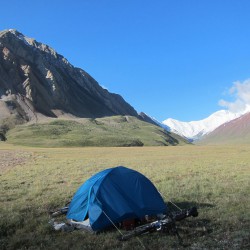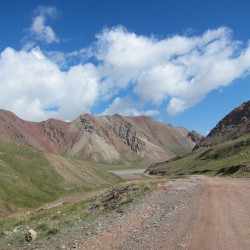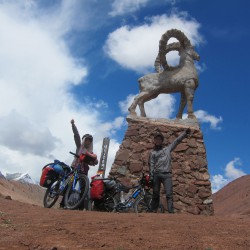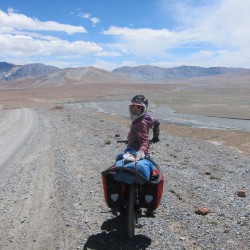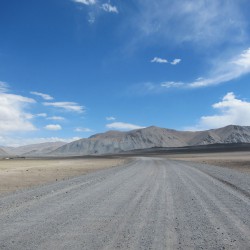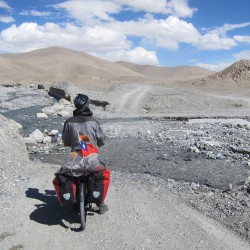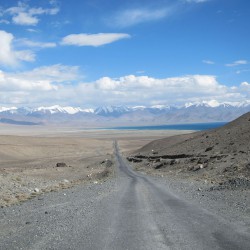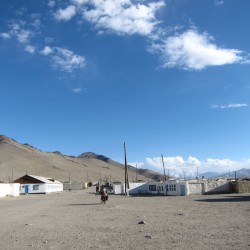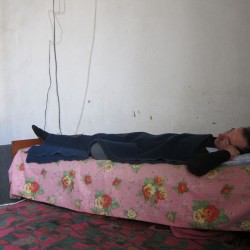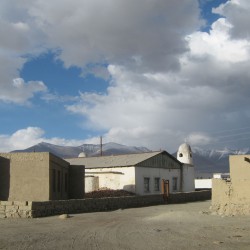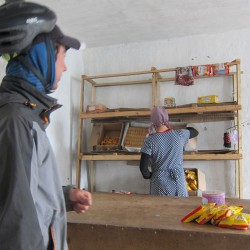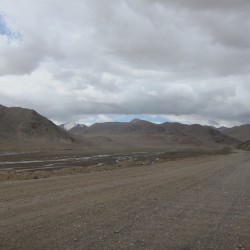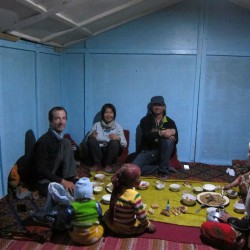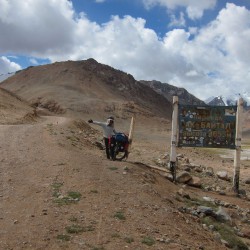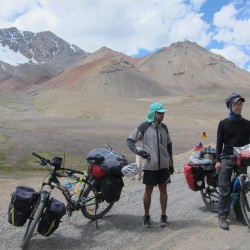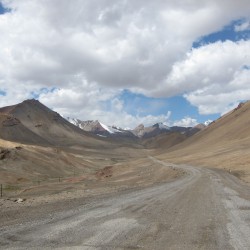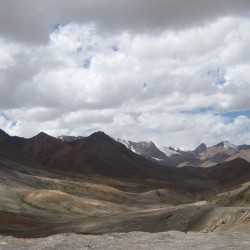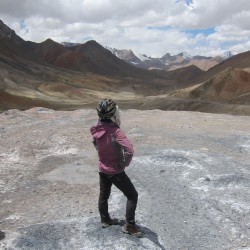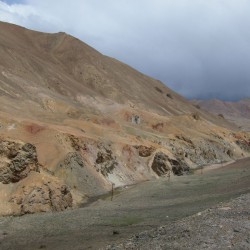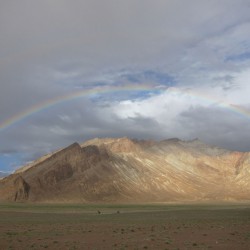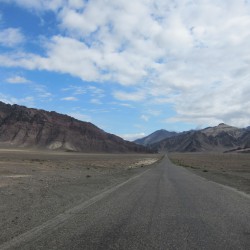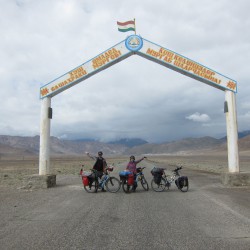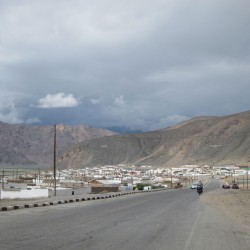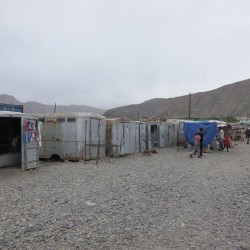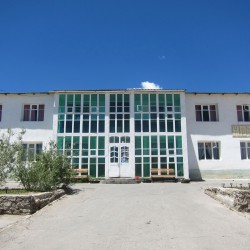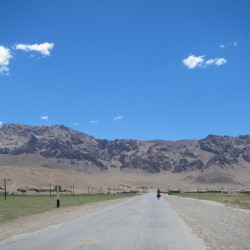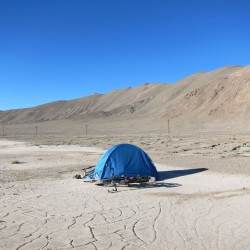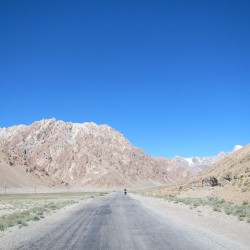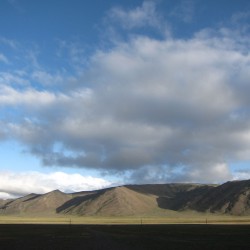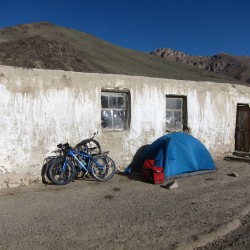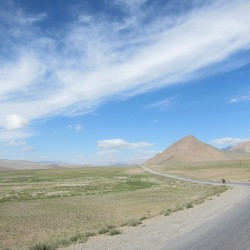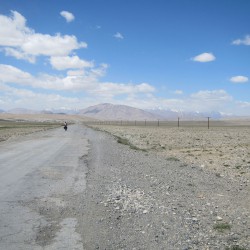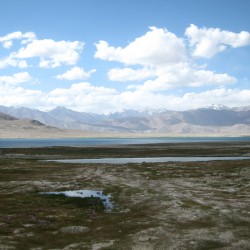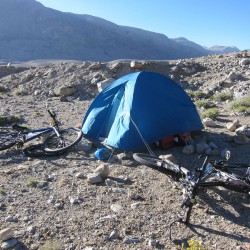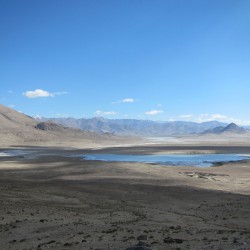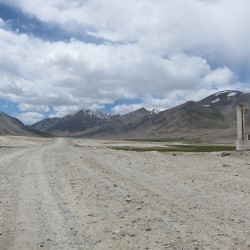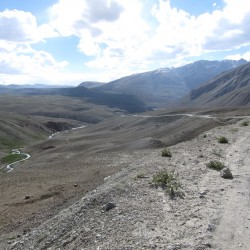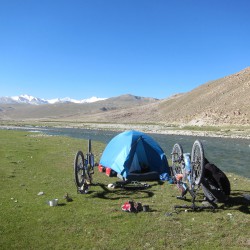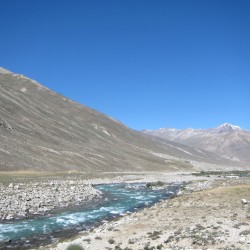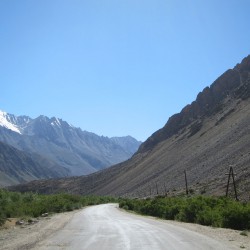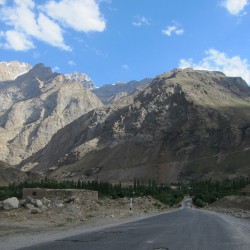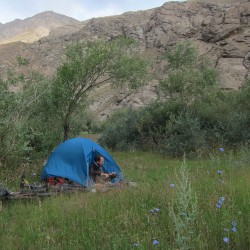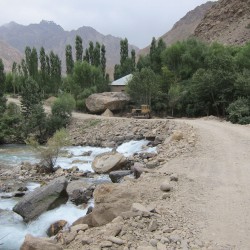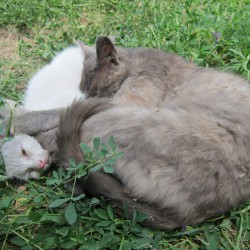The famous Pamir highway. A strip of tarmac that was laid by the Soviets through the high mountains of Tajikistan has reached a high amount of fame from overland tourists. This fame reached me as well: Through several cyclist blogs I’ve been intrigued and just knew that I had to cycle here. Any climate other than the height of summer would be too cold, so most of my season planning was with this stretch of road in mind.
All photos are by Yuily, the text represents my view of things.
No-Mans-Land to Karakul
Sunday, July 10, 2016 – 69 km
There were clear skies as we headed off. The road soon became gravel and dirt, something we’ve been warned about. It wasn’t as bad as the washboard around Song-Kul so I enjoyed riding up.
An older French cyclist soon passed us, going really fast. He revealed that his partner was behind him, who caught us as well a few km later during our lunch break, completely exhausted. She was 65 and kept on pushing, to be caught by us soon again.
Near the pass the road started to make switchbacks and a farmers house was in front of them. The usual kids came running out demanding photos. One of them remained on top of a hill and threw rocks at us. I really wanted to run up the hill and teach him a lesson, but in my exhausted state he would surely run away faster than me, so I resorted to shouting insults at him.
We closed in to the top, huffing increasingly as we went above 4000 m. On the top, at the actual border, two markers and a statue of a Marco Polo sheep waited for us as I fistpumped at an oncoming car. It was one of the harder passes we did so far. During our photo session the French woman pushed past us again, not stopping and cruising downhill to catch her partner, who was long out of sight. I wondered what their relationship was like?
After meeting another French cyclist near the top, we wanted to make our way down to Tajik immigration. 200 m before the post, Yuilys rear tire fizzed to a flat. I wondered why as the hole was on the inside, although the rim was fine. We changed the tube.
I read about some corruption by Tajik customs on this border, with cyclists being charged import and disinfection “fees” for their bikes, but all we were told was “Welcome to Tajikistan”. Smooth crossing.
Tailwind and washboard awaited us on the other side, which was not much of a downhill as we were now on the consistently over 4000 m Pamir plateau. The wind grew stronger as it pushed us over a beautiful plain without much vegetation and 6000+ m peaks around us.
A Polish cyclist came up ahead and he looked absolutely battered, no surprise considering the wind. It was tailwind for us though and soon the glorious asphalt came so we could really enjoy it.
The wind got even stronger and effortlessly pushed us up the next pass, on which I saw two bicycles lying on the ground, with their Czech owners nearby, taking shelter in a ditch. They had absolutely no fun with the wind at all and were considering to camp there.
For us though, these conditions put the village of Karakul still within reach. From another hill then we saw the lake of the same name. Hands down, the most beautiful natural sight I’ve ever seen. Its blue water at 4000 m with grey, red and white mountains surrounding it is one of the reasons so many tourists come to the Pamirs.
The tailwind pushed us on to the village. I wasn’t sure why this collection of bricks was still inhabited, but the touristy nature of this road did its part as it had several homestays. We stayed in none as we camped next to the lake instead.
I attempted to make pasta. I already knew they don’t cook well at high altitude because of the water boiling at 75°C already, but I somehow thought it would work with Spaghetti. It didn’t. I couldn’t drain the water after cooking as it became a paste almost unified with the noodles like a glue. It tasted so horrible that I threw the last bit away, feeling sorry to waste food …
- Camping in No Man’s Land
- Up to the Kyzyl-Art pass
- Made it! Border Kyrgyzstan-Tajikistan
- Enjoying tailwind…
- … on washboard
- A minor river crossing
- Downhill with tailwind to Karakol
- Karakol village
Rest day in Karakul
Monday, July 11, 2016
I was already feeling a funny stomach during the cycle yesterday, but now the glue that was meant to be pasta gave my gut the rest. I couldn’t sleep and made multiple toilet runs.
By morning another problem was appearing: mosquitoes everywhere! They were swarming us as soon as we got out of the tent and stung through our clothes. Packing up was a pain and by the time we did and pushed the bikes to the village, I was on the verge of collapsing. I even tried to force vomit, but it didn’t work. A boy came by, asking in Russian “Drink tea?” Yeah. Sounds good.
We were invited to a house and given some tea with bread, which I could only eat very little of. I had to lie down soon, and luckily our hosts were fine with me lying on the bed, where I slept for most of the day, only interrupted by slowly chewing some food and toilet runs.
Yuily was fantastic during that time. She waited the whole time patiently in the same room while I was sleeping, nursing me and drawing the attention of whoever came into the room without any complaints.
By the end of the day I felt a little better, but it was obvious that we’re going to spend the night.
- Cannot see mosquitoes on the picture…
- A sick man
- Karakul village
Karakul to Yurt Hotel
Tuesday, July 12, 2016 – 48 km
I was initially much better the next morning, but digging in to more food made me feel worse again quickly. I was sick of this and spending any longer in this mosquito infested village that I threw in an antibiotic. It killed whatever I had within two hours and we could cycle.
Between here and Murghab, the next town, were 130 km of nothing and the 4655 m Ak-Baital pass, the highest point of the Pamir highway, which was 60 km from here. The plan was to camp before the pass, so there was no rush today.
We thanked our hosts and they asked for some money for their efforts, which is common – why would they let us stay for free if there are numerous homestays in the village that make tourists pay? They were fine with USD10 and some presents.
We went to the smallest shop I’ve ever seen to get some more cookies and instant noodles for the road and were off. The road was good and flat, leaving the lake, swarms of mosquitoes constantly following us.
Scenery reminiscent of either the moon, Mars or Titan reminded me why I am here. This plateau is just out of this world.
After 40 km the road turned to gravel. Two cyclists appeared and they were really happy to hear from us that they would see asphalt again soon. They also informed us about a Yurt Hotel 8 km further up the road, but we had our minds set on camping.
Another American cyclist was just 2 km after them and offered to exchange his Tajik SIM for my Kyrgyz one. Awesome. A few minutes later a German motorcycle going our direction pulled beside us. The driver, Piet, suggested camping together, which we agreed to, meeting up before the pass started, 6 km further.
Not far from there we saw him stopped next to the Yurt Hotel – he negotiated a price of $15 for the three of us including food. It was the food part that convinced me staying, as their food sounded a lot better than the instant noodles we would have to cook while camping.
We had a fun evening chatting away with Piet, who was on a journey from Germany to South Korea via Russia. It was interesting to chat to a motorbiker – despite the similar transportation, he had very different experiences from cyclists. Mostly, much more distance from locals and more vulnerable to corrupt police.
- The shop in Karakul
- The moon
- Mars
- In the “hotel” with Piet
Yurt Hotel to Wild Camp
Wednesday, July 13, 2016 – 71 km
We were stuffed with awesome Nan and Yak milk before leaving. Piet was unfortunately suffering from altitude sickness and made the decision to turn back to Kyrgyzstan. This has never been a problem for me and Yuily – going up slowly means most cyclists never have this problem.
The big climb started not far from the Yurt. It was harsh, a very steep ascend on gravel. Another cyclist soon caught up behind us – we knew him: It was Timo, the Bulgarian we last met in Osh! We agreed to cycle together.
Although Timo was much faster than us up the hill, he used the time waiting for us taking pictures of the awesome landscape, which Yuily also indulged in. It got colder and we soon were at the top: 4655 m.
We were higher before, the Hasho pass in China up to 4797, but this climb was tougher. It would also be a long time before we ever climb so high again, the next chance probably being in South America.
Downhill from the pass we met more cyclists going the opposite way and the tarmac resumed again. We were invited to tea and bread by a farmer (for a price), perfect timing for lunch. We quickly left again though as we only had 20 km done and wanted to get somewhere today.
The road did a long, gradual downhill all the way to Murghab. Our plan was to camp close to the town, easily roll in the next morning and rest the next day, saving one night accommodation.
A junction of two rivers looked good on the map, but a mosquito infestation made this not an option. Unfortunately a tailwind made it no problem for the mozzies to follow us while cycling, stinging us repeatedly. We agreed to keep cycling until a good spot came in sight.
A wind direction change got rid of the swarms and we went to camp. Soon the wind stopped again though and made the pests swarm us while pitching our tents. We hid in them until sunset when most would disappear. An instant noodle dinner followed, together with a good chat. Timo is very well traveled, speaking many languages fluently and extremely knowledgeable about the world. A privilege to be traveling together with him for a moment!
- Our yurt hotel
- Ak-Baital pass, here we come
- Timo!
- On the way up
- View from the top
- Made it!
- The colors on the rocks were amazing
- A rainbow close to our camp
Wild Camp to Murghab
Thursday, July 14, 2016 – 18 km
Wind in the morning made the mosquitoes less of a problem, so we had no stress packing. After an easy downhill roll we checked into the Pamir Hotel in Murghab. A Soviet-era hotel, it adapted well to the tourist swarms on the Pamir highway, offering cheap, comfortable dorms and hot showers and staff fluent in English and German. Still, the remoteness of the Pamirs and the poor state of the Tajik economy meant that electricity was only available at night.
We did our tasks, like stocking up at the Bazaar (run out of shipping containers), doing laundry, getting a shower.
Getting on the internet revealed that Tajikistan blocks facebook – frustrating attempts to get a free VPN to work were fruitless, so it would have to wait till Korough, 320 km west.
By evening, Yuily was feeling sick and started vomiting – we might spend another night before cycling on…
- The way to Murghab
- Made it!
- Maybe 5000 souls
- The shipping container bazaar
Rest Day in Murghab
Fridayday, July 15, 2016
Well, that’s what we had to do. I figured out Yuilys symptoms and fortunately we brought the right medicine for it. I took care of her as good as I could, trying to give her the same support as she gave me in Karakol.
By evening she felt much better and also regained some appetite.
A walk to the bazaar also revealed some gas cartridges! Cooking limits solved, hooray!
Murghab to Wild Camp
Saturday, July 16, 2016 – 20 km
I couldn’t sleep again as my own stomach bug returned. I was so pissed off at my sickness that I chewed more antibiotics and we started cycling regardless.
Unfortunately, Yuily still didn’t feel very good. We couldn’t stop long either as mosquitoes made any minute a living hell. I felt a bit selfish for trying to cycle fast because of the mozzies when Yuily couldn’t. A yurt was the only option, where we were served the usual tea. The owner offered us to spend the night for TJS40. I was annoyed of spending more money each night, so cycled on to camp.
After a few minutes I was feeling dumb, as it wasn’t much money and Yuily could’ve needed the rest. But fortunately she felt much better later in the tent, thanks to some Vietnamese noodle soup we made.
- The Pamir Hotel
- Onwards to Khorog
- High plateau
- High camp
Wild Camp to Farmers House
Sunday, July 17, 2016 – 65 km
There were around 90 km to go to Alichur, the next sizeable settlement, but we didn’t need to make it that day.
The morning was spent climbing very gradually towards a 4100 m pass. Sometimes mosquitoes made us swat around like crazy, which must’ve looked silly. After the pass, we got a new best friend several people have warned us about already: headwind!
As we grinded on, a bad looking raincloud was blown toward us. It was time to camp anyway, but finding some shelter from the wind was very difficult here. A building appeared and it looked abandoned, so we cycled towards it.
It wasn’t abandoned at all as soon a woman opened the door. Luckily she was fine with us camping there.
- Barely noticeable pass
- Cannot see the wind in the picture
- Later, rain came in
- Someone lived here
Farmers house to Whakan intersection
Monday, July 18, 2016 – 48 km
We rolled toward Alichur the next morning, where we had to restock from a tiny shop and sat in a cafe so I could use some internet: I had to apply for an Iranian visa code for both of us. Unfortunately the internet was too slow to get it to work, so it would have to wait till Khorog.
With it came another realization: We wouldn’t have enough time in Dushanbe to apply for the next three visas one by one. To explain: I wanted to cycle through Uzbekistan and Turkmenistan to Iran, a country I heard only awesome things about. Visas for Uzbekistan and Turkmenistan take at least a week each with Iran a few days as well. To avoid running out of Tajikistan visa time, we need to apply for two at the same time. But Turkmenistan is also a lottery, with rejections very common. If we would get rejected for Turkmenistan then we would have to fly over it, cheapest flights being from Dushanbe. This would mean the (USD100+) visa for Uzbekistan would be wasted.
Flying seemed to be the only way out of this mess without taking risks. It seemed like a defeat, but as other people said: focus on having fun. There is no point in being obsessed to travel overland if you have to do so much bullshit.
I spotted a German car on the way. The drivers, a couple in their 70s, were driving across Eurasia for the third time, this time on the way to Magadan, Russia. They gave us a German lemon cake, which made Yuily very happy.
We cycled on to find a spot to camp. Unfortunately our friend the headwind made it very difficult. We went up to the turn-off for the Whakan valley, a route many cyclists nowadays seem to take (not us). We ended up camping at a rocky spot next to the road and spent over one hour pitching the tent. I was a bit negative about the spot, but Yuily made a fantastic effort securing the tent with ropes and rocks, working away until it seemed rock solid. Awesome. We were still worried it might break, but it held on through the intense winds which continued during the night. Great work, Yuily!
- Cannot see the wind
- Towards Alichur
- A lake on the way
- Secured well by Yuily
Whakan intersection to Roshtqala intersection
Tuesday, July 19, 2016 – 49 km
The winds subsided slightly in the morning, enough to pack our tent without too much trouble. Soon after each other we met two American and two Dutch cyclists who gave us valuable information on the gravel sections and climbs ahead: Three successive passes, the last one being 4200 m with 15 km of gravel. The headwind soon picked up again and was going to annoy us for the rest of the day.
The gravel started soon enough and had us pushing the bikes up the second pass. Our wheels kept jumping while the wind pushed our bikes into sand pits we actually wanted to avoid. A final section of asphalt brought us close enough to the last pass, which wasn’t so steep, so we could ride. I didn’t even mind the headwind, as it made me slow and careful to avoid the big rocks in the road. We met a French cyclist coming the other way, who mentioned that, compared to other routes in the Pamirs, this was a good road.
Coming over the pass, from here it would be all downhill, out of the high Pamirs and the last time we would be above 4000 m. The descend started out flat where we still would have to pedal hard against the wind, but once it got deeper into the Gunt valley, the winds slowly subsided, the roads got steeper and the asphalt re-appeared, so we were making quick progress.
Once the wind was weak enough, we looked for a camping spot. We found a beautiful patch of grass next to the river, our first campspot in a while that could be labeled “beautiful”.
- View when waking up
- Up to the last pass on gravel
- Made it!
- Down to greener lands
Roshtqala intersection to Goz
Wednesday, July 20, 2016 – 51 km
I had a cold night – I looked forward to lower altitudes. We had no pressure to get over hills anymore though, so we had a relaxing morning, letting the morning sun warm us. We also knew there was a hot spring down the road, which we were looking forward to enjoy.
As we got there, the first thing we noticed was that the village and its locals looked noticeably different. The Pamir plateau was mostly populated with ethnically Kyrgyz people, but the valley here was composed of Pamiri people, who are ethnically Persian, many with characteristically green eyes. The cheerful greetings and “Hello” from the kids was the same, though.
We found one house that has hot springs on offer for TJS5 per person and soaked for a while. We then met Jonathan, a German amazingly tackling the Pamirs on a folding bike! We really wondered how he got over gravel bumps with that, but then again this thing was really no problem to transport in a car.
Rolling down the valley, we were craving for lunch. Just then, we got an invitation for tea. A lovely lady in her 20s who spoke some English treated us in her house as we could see that these dwellings were noticeably wealthier than those on the Pamirs. Yuily thanked her by giving her some Taiwanese tea as a present.
The scenery became very very beautiful to us. We slowly cut below the treeline again as everything became increasingly green, agriculture being possible again. Huge rocks and massive mountains over 6000 m were still towering over the valley, reminding us that we were still in the Pamirs.
Despite being all downhill on asphalt with only a slight headwind, we decided to camp at a beautiful spot after just under 50 km. It was nicely tucked away from the road, grassy and next to a clean creek. Life was good.
- Nice camp
- Down the Gunt river
- Getting greener
Goz to Tang
Thursday, July 21, 2016 – 64 km
After a good night, we were 90 km away from Khorog, the regional capital, where rest days were planned. As it became a routine, we planned to camp just before there to check in the next morning, fully utilizing the rest with paying one night less.
We got an invitation for tea which we accepted. The people here were not expecting money for those invitations, unlike the Kyrgyz. It may sound unbelievably stingy, but the whole time in Kyrgyzstan and on the Pamir plateau, I was careful to accept any invitations as people usually expected and asked for money in the end. It was not much at all, but it still rather made me cycle on. As Yuily stated it, this is not hospitality, but business. I know these people are poor, but the Tibetans in China were as well, and yet there, almost nobody ever asked for anything in return of us and if they did, they were up-front with it. Here in Pamiri areas, it felt like genuine hospitality again – I’m not sure if they would have accepted if we offered money, but I couldn’t be sure if the offer would’ve been offensive to them or possibly encouraging the same behaviour as in Kyrgyz areas towards Tourists.
We camped just after we met four Russian cyclists in the other direction. The area was much more populated now, but after some looking we eventually found a spot tucked away between a line of trees and a stone wall with an irrigation creek flowing next to it.
- Lovely
- Scary bridges
- Going deeper into the Gunt
Tang to Khorog
Friday, July 22, 2016 – 29 km
It was an easy morning cycle into Khorog, despite a 3 km section of gravel where the original road was flooded. Just before town, there was a police checkpoint that waved us through and we met four Polish cyclists there, trying to hitchhike due to soon expiring visas and stomach troubles. Nearly every foreigner we met so far had food poisoning in Tajikistan – I hoped that our turn was over with the sicknesses from Karakol and Murghab!
Just after the checkpoint we heard a loud meow from the roadside. There was a kitten on the side of the road. In that location it was surely going to die if we left it there, so we picked it up and put it in my handlebar bag.
We rolled into Khorog and the cheapest place in town, the Pamir Lodge. This place primarily attracts overlanders, not just on bicycles, but also motorbikes and cars. It has been recommended to us by basically everyone we met on the road and it was easy to see why. Clean, with a green courtyard, next to the mountain with lots of like-minded people to meet, this was an excellent place to rest a few days.
We brought the kitten in, claiming we found it just outside their gate. The staff initially mentioned they have too many cats already, but didn’t seem to want to chase it out anyway. This story had a happy ending, as one of the local cats developed a strong mother complex for the kitten within hours, spending all her time with it.
As we socialized with the other guests, we went out into the city that evening. And I really say “city”. Khorog is such a pleasant place, nested beautifully between the mountains with cheerful people, a beautiful park in the city center and relatively modern buildings. It was the first city we’ve seen since Osh and I was happy to see that kind of infrastructure again.
I already figured this in the Pamirs, I am no serious adventure seeker. A long, remote stretch of road without shops or mobile reception is making me more frustrated than excited, and being in a city that has the comforts of life makes me happy. Of course cycling in densely populated areas is not so much fun either, but I like to have a decent concentration of towns with shops and internet on the way so I don’t have to pre-plan as much. The Tibetan plateau was actually ok in that regard, but the Pamir plateau a bit too remote for my taste. I was glad we didn’t choose the even more remote Whakan or Bartang routes.
In general, seeing the huge amount of cars, motorbikes and bicycles in the Pamir Lodge made me wonder: When did the Pamir highway become so touristy, and why? It was a great experience that I don’t regret, but we both agreed that the Tibetan plateau in Western Sichuan, China, was a better experience. Even more stunning landscapes, more friendly locals and, most of all, better roads. Most cyclists we met in Tajikistan were on a short trip, flying in to Dushanbe and out of Osh or Bishkek, many on a search of remoteness and adventure. Due to this desire, the Whakan valley road is now actually more popular with cyclists than the main highway, despite being longer and in much worse condition, while also an increasing amount of is drawn towards the even more remote Bartang and Zorkul routes, which are little more than tire tracks through the mountains. A few of these cyclists even came to the Pamirs a second time. I just thought a lot of these cyclists could feed their desire for adventure, remoteness and beautiful high altitude scenery more easily by visiting the West Sichuan or Qinghai areas of China…
- Not so bad
- A bit of gravel
- Our kitten getting adopted
- Khorog city
